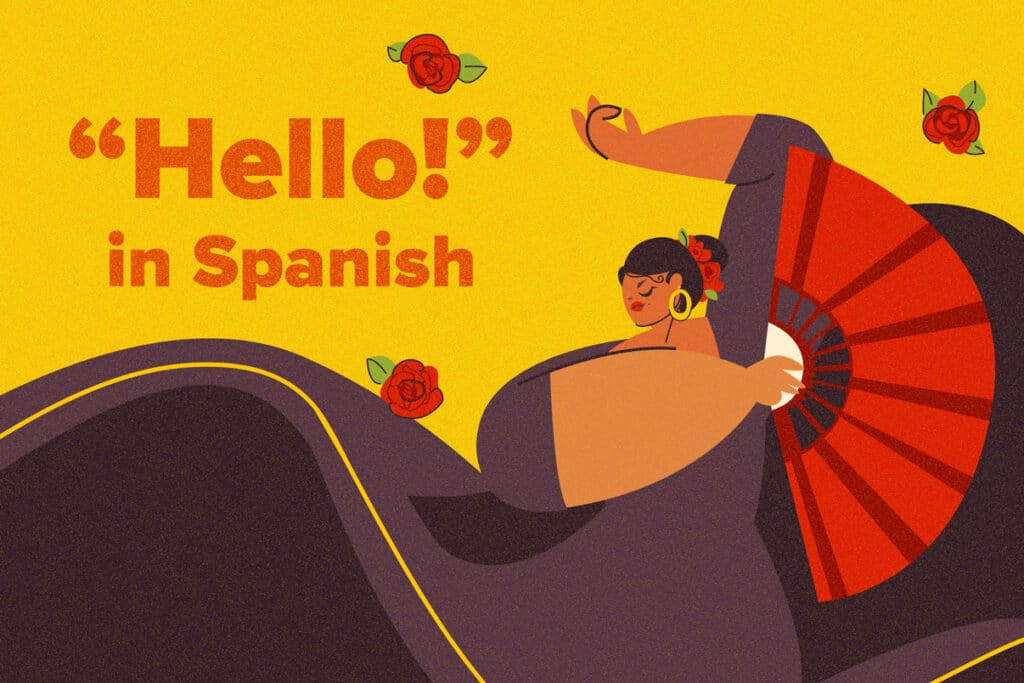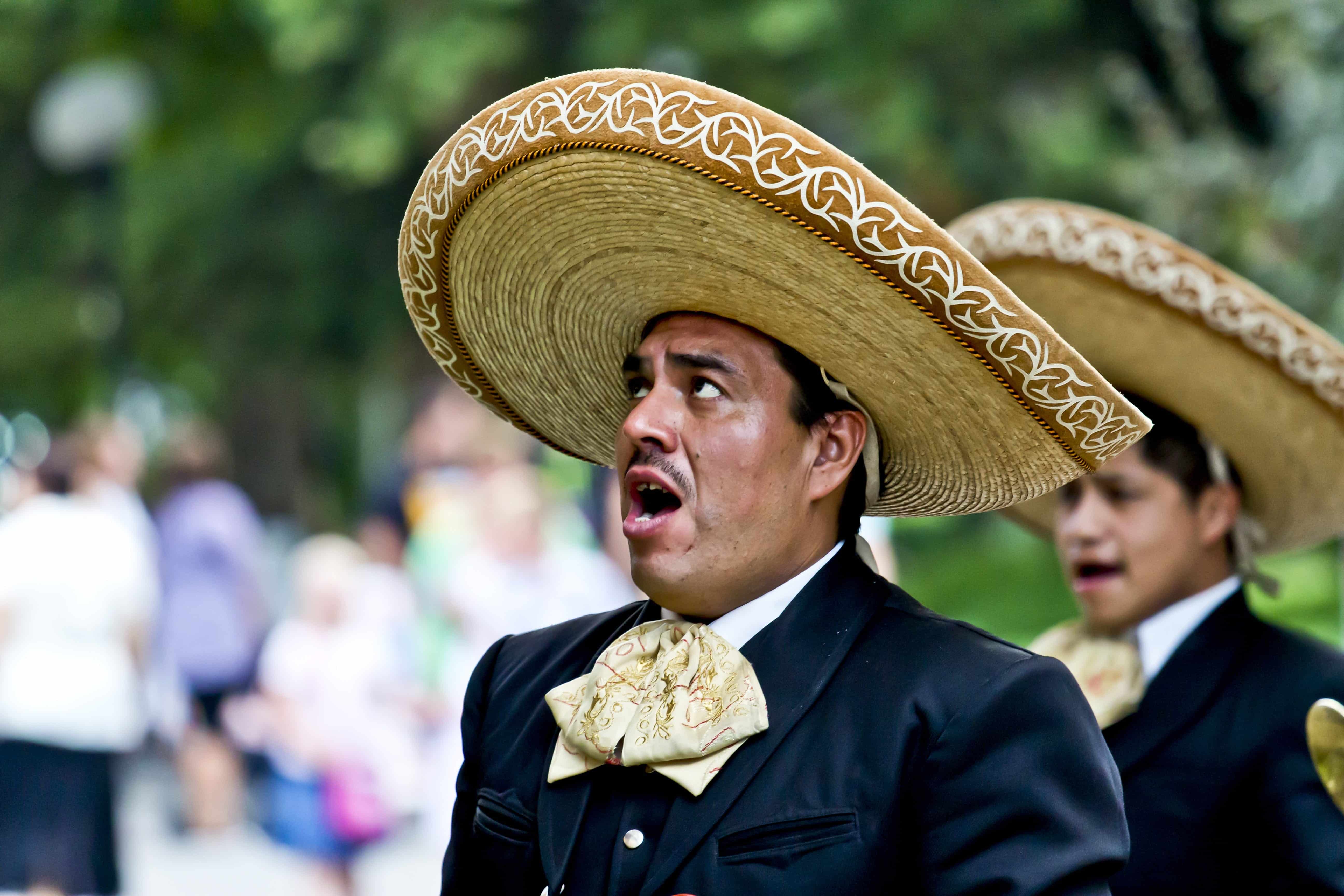
76 Ways to Say Hello and Greet People in Spanish
Knowing how to say “hello” in Spanish is probably the first and single most important skill to master as a Spanish learner.
And Spanish greetings, depending on the situation, go way beyond hola (hello).
In this post, we’re going to go over 76 greetings and introductions you can use to say hello in Spanish. We’ll also explain a little about when and how to use each one.
We’ve also included phone greetings, email greetings, country-specific greetings and a section on non-verbal greetings that are common in the Spanish-speaking world.
Contents
- Top Ways to Say “Hello” in Spanish
-
- 1. ¡Hola! — Hello
- 2. Buenos días — Good morning
- 3. Buenas tardes — Good afternoon
- 4. Buenas noches — Good evening
- 5. ¿Cómo está? — How are you? (Formal)
- 6. ¿Cómo estás? — How are you? (Informal)
- 7. ¿Cómo están? — How are you? (Plural)
- 8. ¿Qué tal? — How’s it going?
- 9. ¿Qué pasa? — What’s happening? / What’s up?
- 10. ¿Qué hubo? — How’s it going?
- 11. Bienvenidos — Welcome
- 12. Mi casa es su casa — My house is your house
- 13. ¿De dónde eres? — Where are you from?
- 14. ¿Cómo te llamas? — What’s your name?
- 15. ¿Aló? — Hello?
- 16. ¿Adónde vas? — Where are you going?
- 17. ¿Dónde has estado? — Where have you been?
- 18. ¡Hace tiempo que no te veo! — It’s been a while since I’ve seen you!
- 19. Mucho gusto — Nice to meet you
- 20. ¿Qué onda, microonda? — What wave, microwave?
- 21. ¿Qué pasa, huevón? — What’s up, dude?
- How to Answer the Phone in Spanish
-
- 22. ¡Hola! — Hello!
- 23. ¡Buenas! — Hi there!
- 24. ¡Saludos! — Greetings!
- 25. ¿Qué hay de nuevo? — What’s new?
- 26. Hola, ¿qué onda? — Hey, what’s up?
- 27. ¡Buenas tardes! — Good afternoon!
- 28. ¡Dígame! — Tell me!
- 29. ¡Sí! — Yes!
- 30. ¡Aló! — Hello!
- 31. ¡Diga! — Speak!
- 32. ¿En qué puedo colaborar? — How can I help you?
- Formal Spanish Greetings
- Informal Email Spanish Greetings
-
- 36. Querido / Querida / Queridos / Queridas — Dear
- 37. ¡Hola! Espero que este mensaje te encuentre bien. — Hello! I hope this message finds you well.
- 38. ¡Buen día! — Good day!
- 39. ¡Saludos! — Greetings!
- 40. ¡Hola! Quería ponerme en contacto contigo para… — Hello! I wanted to get in touch with you regarding…
- 41. ¡Estimado / Estimada [Nombre]! — Dear [Name]!
- 42. ¡Saludos cordiales! ¿Cómo va todo por tu parte? — Warm regards! How is everything on your end?
- 43. ¡Hola, [Nombre]! ¿Cómo te encuentras hoy? — Hello, [Name]! How are you today?
- 44. ¡Saludos afectuosos! ¿Cómo va todo contigo? — Affectionate greetings! How’s everything with you?
- 45. ¡Dígame! ¿En qué puedo ayudarle con respecto a este asunto? — Tell me! How can I help you regarding this matter?
- 46. ¡Aló! Quería consultarte acerca de… — Hello! I wanted to ask you about…
- How to Greet Someone Via Text Message
- Formal Email Spanish Greetings
- Country Specific Greetings in Spanish
- Nonverbal Spanish Greetings
- FAQs about Saying “Hello” in Spanish
- And One More Thing…
Download: This blog post is available as a convenient and portable PDF that you can take anywhere. Click here to get a copy. (Download)
Top Ways to Say “Hello” in Spanish

Now say hello to these useful greetings and introduction phrases. After all, first impressions are everything.
1. ¡Hola! — Hello
This is the most basic of the greetings, and can be combined with any of the other ones found below. Now you can say, Hola, buenos días or Hola, buenas tardes. The h is silent!
2. Buenos días — Good morning
Literally meaning “good day,” it can also mean “good morning.” Buenos días is usually used until noon.
3. Buenas tardes — Good afternoon
If you want to say “good afternoon,” and it’s one o’clock or later in the day, you can say buenas tardes.
In Spain, it may be used until later in the evening, while in most Latin American countries and the Caribbean, it may be used until the sun goes down.
4. Buenas noches — Good evening
This phrase also means “goodnight.” Always be mindful of the context since you could be saying goodbye.
5. ¿Cómo está? — How are you? (Formal)
This is a formal way of asking how someone is feeling. It’s usually reserved for older people, authority figures or as a sign of respect. In some South American countries, always use this one to be on the safe side.
Are you conducting business? It is important that you inquire about a person’s well-being before beginning any type of business talk. It’s an indication that you care about your client.
6. ¿Cómo estás? — How are you? (Informal)
The S at the end indicates that you’re talking to someone your same age or younger. If you hear tutéame, you have permission to address the person in the informal way, regardless of age.
7. ¿Cómo están? — How are you? (Plural)
Greeting a group of people? The N at the end will indicate that you just said hello to everyone.
Traveling to Spain? Say: ¿Cómo estáis? instead.
8. ¿Qué tal? — How’s it going?
For some it may be informal, but in general this question can be used with anyone in a non-business setting.
9. ¿Qué pasa? — What’s happening? / What’s up?
Talking to your friends or someone younger than you? Use the phrase ¿Qué pasa? You may also hear this one when someone wants to know if something is wrong.
10. ¿Qué hubo? — How’s it going?
This is considered informal in some countries. Use it with your friends and family. Just remember the rule about the silent H.
11. Bienvenidos — Welcome
Want to welcome someone to your home? Use this friendly greeting.
Keep the final S if you are welcoming more than one person. Drop the final S and it becomes singular.
If you’re speaking to a female, you’ll say bienvenida, but for a gentleman, say bienvenido. Welcoming a group of females? Use the word bienvenidas. It may sound chauvinistic, but use the form bienvenidos if it is a mixed group.
12. Mi casa es su casa — My house is your house
If you want to make someone comfortable in your home, you can say this. You’re not really giving your house away, but you are indicating that they can feel at home.
If you invited someone your same age, change the su to tu.
13. ¿De dónde eres? — Where are you from?
Use this phrase when you want to ask someone your age or younger where they’re from. The question will change to ¿De dónde es usted? if you’re speaking to an adult or an authority figure.
14. ¿Cómo te llamas? — What’s your name?
This literally means “What do you call yourself?” and this is what you ask to find out someone’s name. It does have a few variations depending on formality. If you want to ask someone older in Spanish you say, ¿Cómo se llama?
15. ¿Aló? — Hello?
This is a common way of answering the phone in many Spanish-speaking countries. Depending on where you travel, you may hear bueno, sí, and diga used for answering a phone call.
Regardless of the greeting, respond by saying who you are and make sure to inquire how they are. It’s impolite not to ask! Thank them very much. Then, state the purpose of your call.
16. ¿Adónde vas? — Where are you going?
Saying hello to someone who’s in a rush? To ask someone where they’re going in Spanish, say this phrase. Change it to va for formal conversations and if you’re asking a group of people where they’re going in Spain, change the last word to vais.
17. ¿Dónde has estado? — Where have you been?
Has it been a long time since you’ve seen someone? Say hola and find out where they have been. Be prepared to get the whole story!
18. ¡Hace tiempo que no te veo! — It’s been a while since I’ve seen you!
You’re saying hello, but it’s been ages since you’ve seen them.
19. Mucho gusto — Nice to meet you
This is an easy thing to say to anyone you’re meeting for the first time. It literally means “much pleasure,” but you can use it to express your happiness in meeting someone.
20. ¿Qué onda, microonda? — What wave, microwave?
This is an incredibly stupid (or funny, depending on your mindset) way to greet people in Chile, where the more standard ¿Qué onda? (What’s up?) rules the day.
21. ¿Qué pasa, huevón? — What’s up, dude?
This fun greeting is pretty much just used in South America.
Here’s a fun video on Spanish greetings and introductions:
How to Answer the Phone in Spanish

Answering the phone is sometimes scary in another language, because you don’t know what the caller is going to say. But with these foolproof Spanish phone greetings, you’ll start the conversation out right.
22. ¡Hola! — Hello!
23. ¡Buenas! — Hi there!
24. ¡Saludos! — Greetings!
25. ¿Qué hay de nuevo? — What’s new?
26. Hola, ¿qué onda? — Hey, what’s up?
27. ¡Buenas tardes! — Good afternoon!
28. ¡Dígame! — Tell me!
29. ¡Sí! — Yes!
30. ¡Aló! — Hello!
31. ¡Diga! — Speak!
32. ¿En qué puedo colaborar? — How can I help you?
Formal Spanish Greetings

For your average high-falutin’ folks, you can use:
33. Señor — Mr.
34. Señora — Mrs.
If you’re having proper adventures in Spain or Latin America, you may eventually need to know how to address a judge:
35. Honorable — Honorable
Informal Email Spanish Greetings

In emails to friends, family and even close business associates, you can write the following greetings to start things off:
36. Querido / Querida / Queridos / Queridas — Dear
37. ¡Hola! Espero que este mensaje te encuentre bien. — Hello! I hope this message finds you well.
38. ¡Buen día! — Good day!
39. ¡Saludos! — Greetings!
40. ¡Hola! Quería ponerme en contacto contigo para… — Hello! I wanted to get in touch with you regarding…
41. ¡Estimado / Estimada [Nombre]! — Dear [Name]!
42. ¡Saludos cordiales! ¿Cómo va todo por tu parte? — Warm regards! How is everything on your end?
43. ¡Hola, [Nombre]! ¿Cómo te encuentras hoy? — Hello, [Name]! How are you today?
44. ¡Saludos afectuosos! ¿Cómo va todo contigo? — Affectionate greetings! How’s everything with you?
45. ¡Dígame! ¿En qué puedo ayudarle con respecto a este asunto? — Tell me! How can I help you regarding this matter?
46. ¡Aló! Quería consultarte acerca de… — Hello! I wanted to ask you about…
How to Greet Someone Via Text Message

As with other languages, most friendly written communication in Spanish is now limited to what you can poke out on your mobile device screen (incidentally, WhatsApp is the most popular service for this in Spain and much of Latin America). Often, vowels are omitted. (Check out our excellent full guide to text-message talk in Spanish.)
47. Hla— Hello
48. Q tl? — How are you?
This is from ¿Qué tal? I have to admit, a lot of my own Spanish friends do spell this out a bit more as q tal?, but many of them are also over 30.
49. Bs — Kisses (from besos)
50. a10 — Wait
Before you read further, can you figure this out on your own? Think about how it’s pronounced. If you guessed adiós (goodbye), congrats!
Formal Email Spanish Greetings

At the beginning of a formal email, you can use the following phrases followed by a colon ( : ).
51. A quien corresponda: — To whom it may concern
52. Estimado señor / Estimada señora / Estimados señores / Estimadas señoras: — Literally: esteemed sir/madam/sirs/madams
The above two greetings are particularly useful for starting an email when you don’t know the name of the person you’re addressing, like when writing to a company. If you do know the name, just add it. For example: Estimado Señor Almodóvar.
53. Muy señor mío: / Muy señora mía: / Muy señores míos: / Muy señoras mías: — Very much my dear sir/madam/sirs/madams
For some extra help learning these super-useful greetings, look for them in authentic media. For instance, you can see them in use in native Spanish videos like movie clips and vlogs on FluentU.
FluentU takes authentic videos—like music videos, movie trailers, news and inspiring talks—and turns them into personalized language learning lessons.
You can try FluentU for free for 2 weeks. Check out the website or download the iOS app or Android app.
P.S. Click here to take advantage of our current sale! (Expires at the end of this month)

Country Specific Greetings in Spanish

Mexico
- ¿Qué onda, güey? — What’s up dude?
- ¿Qué rollo? — What’s up?
- ¿Qué pex? — What’s up?
- ¿Qué tranza? — What’s going on?
- ¿Qué pasión? — What’s going on?
Spain
- ¿Qué tal? — Hello! How’s it going?
- Hola, tío — Hey man
- ¿Cómo va la cosal? — How are things?
- ¿Qué te cuentas? — What’s new?
Argentina
- ¡Hola, che! ¿Cómo andás? — Hello there! How are you getting along?
- ¡Buenas y santas! — Good day!
- ¡Ave María purísima! — Purest Virgin Mary!
Colombia
- ¡Hola, parcero! — Hello, buddy!
- ¿Quiubo? — What’s up?
- Bien, ¿o qué? — Good or what?
Chile
- ¡Hola, po! ¿Cómo estai? — Hello! How are you?
- ¡Wena! — Good day!
Venezuela
- ¡Hola, pana! — Hello, friend!
- ¡Épale! — Hi!
- ¿Qué pasó, papá? — What’s going on, dad?
Peru
- ¡Hola, causa! — Hey, what’s up?
Dominican Republic
- ¡Hola, manin! — Hey bro!
Cuba
- ¿Qué bola? — What’s up?
Costa Rica
- ¡Hola, mae! ¿Cómo estás? — Hello, mate! How are you?
- ¡Pura vida! — Literally: pure life; can be used as a greeting and a goodbye
Nonverbal Spanish Greetings

Kisses
Let’s get those lovely cheek kisses straight first. In Latin America, you do one kiss on one cheek for personal greetings. In Spain, one does two kisses, one on each cheek.
To answer a popular Anglophone question: generally the cheeks just rub together and you kiss the air, but if the cheek in question is extra pinchable, or if there’s a lot of enthusiasm or affection involved, lips may actually brush cheeks. Usually people go first left then right.
Generally two men don’t cheek-kiss each other hello or goodbye, except in some circles and in Spain. However, men are likely to kiss when congratulations are in order between close friends or relatives—for example the bride and groom usually get dos besos (two kisses) from all of the guests.
In some Latin American countries, kisses are also sometimes used as greetings in business situations between men and women or two women.
Handshakes and occasional hugs
Handshakes are used in business situations and among male friends both in Spain and Latin America. One-armed hugs with a bit of back-slapping can be employed to show enthusiasm.
FAQs about Saying “Hello” in Spanish
How do you say “hello” in Spanish?
Hola.
What are common greetings in Spanish-speaking countries?
Greetings can vary, but common ones include Hola, ¿Cómo estás? (How are you?), Buenos días (Good morning), Buenas tardes (Good afternoon) and Buenas noches (Good evening/night).
Are there different greetings for formal and informal situations in Spanish?
Yes, there are. For example, Hola is generally informal, while Buenos días/tardes/noches can be used in more formal situations.
How do you respond to “¿Cómo estás?” (How are you?) in Spanish?
Common responses include Bien, gracias (Good, thank you) or Muy bien (Very well). In more formal situations, you might say Estoy bien, gracias.
What is the equivalent of “What’s up?” in Spanish?
It varies across regions, but common informal expressions include ¿Qué tal? or ¿Qué onda? In some countries, you will hear ¿Cómo va? or ¿Cómo te va?
When is it appropriate to use titles in greetings in Spanish?
Titles like Señor (Mr.), Señora (Mrs.) or Señorita (Miss) are often used in more formal situations or when addressing someone you don’t know well. In informal situations, first names are more common.
How do you say goodbye in Spanish?
Common ways to say goodbye include Adiós, Hasta luego (See you later) or Hasta pronto (See you soon).
If you want to learn more, we also have an excellent and complete post on greeting your people in more informal ways.
Now go out and say hello. Maybe you’ll make some Spanish-speaking friends!
Download: This blog post is available as a convenient and portable PDF that you can take anywhere. Click here to get a copy. (Download)
And One More Thing…
If you've made it this far that means you probably enjoy learning Spanish with engaging material and will then love FluentU.
Other sites use scripted content. FluentU uses a natural approach that helps you ease into the Spanish language and culture over time. You’ll learn Spanish as it’s actually spoken by real people.
FluentU has a wide variety of videos, as you can see here:

FluentU brings native videos within reach with interactive transcripts. You can tap on any word to look it up instantly. Every definition has examples that have been written to help you understand how the word is used. If you see an interesting word you don’t know, you can add it to a vocab list.

Review a complete interactive transcript under the Dialogue tab, and find words and phrases listed under Vocab.

Learn all the vocabulary in any video with FluentU’s robust learning engine. Swipe left or right to see more examples of the word you’re on.

The best part is that FluentU keeps track of the vocabulary that you’re learning, and gives you extra practice with difficult words. It'll even remind you when it’s time to review what you’ve learned. Every learner has a truly personalized experience, even if they’re learning with the same video.
Start using the FluentU website on your computer or tablet or, better yet, download the FluentU app from the iTunes or Google Play store. Click here to take advantage of our current sale! (Expires at the end of this month.)








